
Uebelmannia pectinifera Photo by: Valentino Vallicelli
This is one of the most striking and recognisable Uebemannia with a green to deep purple or reddish-brown, firm, almost lizard-skin textured 'skin' and spines on vertical ribs.
Origin and Habitat: Uebelmannia pectiniferaSN|14312]]SN|14312]] is only known from one location, north east of Diamantina, mountain of Minas Gerais, in Brazil (extent of occurrence 3,000 km2).
Altitude: 650 to 1350 above sea level.
Habitat: The plants are found growing in campo rupestre (dry savanna) and rocky areas in rock cracks or in pockets or small flat areas of organic leaf mould and sand found among crystalline rocks. Uebelmannia pectiniferaSN|14312]]SN|14312]] has small range and the population is at risk due to several threats, the main one being overcollection, which cause a continuing decline of individuals. The population is severely fragmented. Hence, it is listed as Endangered. This species is more common in collections than it is in habitat.
Synonyms:
See all synonyms of Uebelmannia pectinifera
Common Names include:
PORTUGUESE (Português): Quiabo-da-lapa
Description: Uebelmannia pectiniferaSN|14312]]SN|14312]] is a solitary cactus 10-50(-100) cm tall. It is a multiform species and very variable in habitat, comprising a complex of numerous local forms, where each form is linked to others by populations of plants with intermediate characteristics. Three subspecies are recognized, the nominate form (subsp. pectinifera), subsp. flavispina (Buining & Brederoo) P.J.Braun & Esteves and subsp. horrida (P.J. Braun) P.J. Braun & Esteves. The circumscription into subspecies possibly represents convenient over-simplification of the situation in nature.
Stem: Solitary or (rarely) aggregated, globular to fusiform or elongated or cylindrical, it is reported to grow to as much as 1 m tall and 10-15(-17) cm wide with gummiferous ducts under the epidermis. The epidermis is dark reddish-green to reddish-brown or green to grey-green, with or without waxy plates and rough. (In cultivation the colour of the plants depends on sun exposure, the plants grown in shadow are green with white stripes, while the ones in full sun take on a dark frost brown or purple colour) .
Ribs: 13-40 (15 to 18 in subsp. pectinifera), acute, straight, vertical and prominent, not tuberculate, to 5 mm high and 5-7 mm broad.
Areoles: 2 mm in diameter set closely (less than 3 mm apart), to form an almost continuous felt-like line down the ribs' sides, with sparse greyish or brownish wool when young, later glabrescent.
Central spines: Dark brown/grey to black, but also whitish or yellowish brown,1 to 4, up to 1.5(-2) cm long; the spines are close set, often interlacing, neatly arranged and give a comb-like effect. They're porrect or spreading, and straight.
Radial spines: Absent.
Flowers: Diurnal, slender funnel-shaped greenish yellow. They are 8-16 mm long, 6-10(-12) mm in diameter. Tube to c. 8 mm, with triangular bract-scales, white hairs and bristles. Perianth-segments pale yellow, tinged reddish or greenish; style 6-7 mm; stigma-lobes 7-8.
Blooming season: Flowers come sporadically from Early spring to Late Summer.
Fruits: Pear shaped to cylindrical, violet-red to bright pinkish, 1.5-2.5 cm long 6-8 mm wide, with few glabrescent or slightly woolly bract-scales.
Seeds: 1.7-2.4 x 1.3-1.6 mm, keeled, brown, shiny, smooth; testa cells flat.
Subspecies, varieties, forms and cultivars of plants belonging to the Uebelmannia pectinifera complex
 Uebelmannia pectinifera Buining: (ssp. pectinifera) It has about 18 ribs and slowly grow up to 50 cm in height. Origin: It comes from the mountains in the higher part of the areal.
Uebelmannia pectinifera Buining: (ssp. pectinifera) It has about 18 ribs and slowly grow up to 50 cm in height. Origin: It comes from the mountains in the higher part of the areal. Uebelmannia pectinifera var. crebispina n.n.: Barao de Quacuy, Minas Gerais, Brazil.
Uebelmannia pectinifera var. crebispina n.n.: Barao de Quacuy, Minas Gerais, Brazil. Uebelmannia pectinifera var. eriocactoides Řepka, Krajča & V.Toman: The seedlings closely resemble to juvenile plants of Eriocactus leninghausii, hence the name.
Uebelmannia pectinifera var. eriocactoides Řepka, Krajča & V.Toman: The seedlings closely resemble to juvenile plants of Eriocactus leninghausii, hence the name. Uebelmannia pectinifera subs. flavispina (Buining & Bredero) P.J.Braun & Esteves: It has up to 29 ribs with amber yellow spines, and can grow about 35 cm tall. Origin: west of Diamantina.
Uebelmannia pectinifera subs. flavispina (Buining & Bredero) P.J.Braun & Esteves: It has up to 29 ribs with amber yellow spines, and can grow about 35 cm tall. Origin: west of Diamantina. Uebelmannia pectinifera subs. flavispina var. longispina n.n.: like subsp. flavispina, but spines longer and thicker. Distribution: Guinda, Minas Gerais, Brazil.
Uebelmannia pectinifera subs. flavispina var. longispina n.n.: like subsp. flavispina, but spines longer and thicker. Distribution: Guinda, Minas Gerais, Brazil. Uebelmannia pectinifera subs. horrida (P.J.Braun) P.J.Braun & Esteves: Stem with more than 23 ribs (up to 40) it is the taller of the three and can reach 1 m of height. Origin: Serra do Espihaço.
Uebelmannia pectinifera subs. horrida (P.J.Braun) P.J.Braun & Esteves: Stem with more than 23 ribs (up to 40) it is the taller of the three and can reach 1 m of height. Origin: Serra do Espihaço. Uebelmannia pectinifera var. multicostata Buining & Bredero: has 20 or more ribs. Distribution: 10 km E of Mendanha towards the Rio Jequitinhonha, Minas Gerais, Brazil.
Uebelmannia pectinifera var. multicostata Buining & Bredero: has 20 or more ribs. Distribution: 10 km E of Mendanha towards the Rio Jequitinhonha, Minas Gerais, Brazil. Uebelmannia pectinifera var. pseudopectinifera Buining: has smaller and greener stems, with separate (not confluent) areoles without brush-like spines. Distribution: Diamantina, Minas Gerais, Brazil.
Uebelmannia pectinifera var. pseudopectinifera Buining: has smaller and greener stems, with separate (not confluent) areoles without brush-like spines. Distribution: Diamantina, Minas Gerais, Brazil. Uebelmannia pectinifera f. variegata hort.
Uebelmannia pectinifera f. variegata hort.
Bibliography: Major references and further lectures
1) Edward Anderson “The Cactus family” Timber Press, Incorporated, 2001
2) James Cullen, Sabina G. Knees, H. Suzanne Cubey "The European Garden Flora Flowering Plants: A Manual for the Identification of Plants Cultivated in Europe, Both Out-of-Doors and Under Glass" Cambridge University Press, 11/Aug/2011
3) David R Hunt; Nigel P Taylor; Graham Charles; International Cactaceae Systematics Group. "The New Cactus Lexicon" dh books, 2006
4) Machado, M., Taylor, N.P. & Braun, P. 2013. Uebelmannia pectinifera. In: IUCN 2013. "IUCN Red List of Threatened Species." Version 2013.2. <www.iucnredlist.org>. Downloaded on 08 January 2014.
5) Nigel P. Taylor, Daniela C. Zappi “Cacti of Eastern Brazil”Royal Botanic Gardens, Kew, 2004
 Uebelmannia pectinifera Photo by: Flavio Agrosi
Uebelmannia pectinifera Photo by: Flavio Agrosi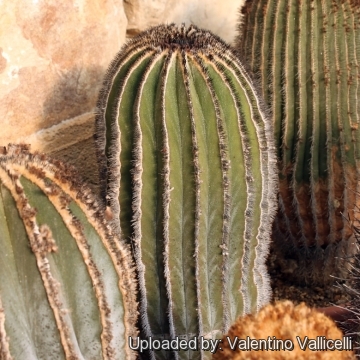 Uebelmannia pectinifera Photo by: Valentino Vallicelli
Uebelmannia pectinifera Photo by: Valentino Vallicelli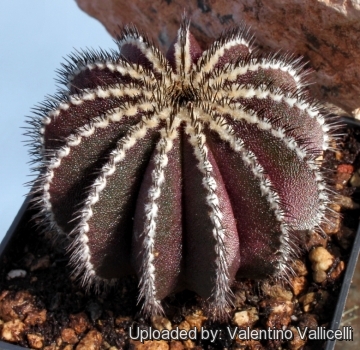 Uebelmannia pectinifera Photo by: Valentino Vallicelli
Uebelmannia pectinifera Photo by: Valentino Vallicelli Uebelmannia pectinifera Photo by: Cactus Art
Uebelmannia pectinifera Photo by: Cactus Art Uebelmannia pectinifera Photo by: Valentino Vallicelli
Uebelmannia pectinifera Photo by: Valentino Vallicelli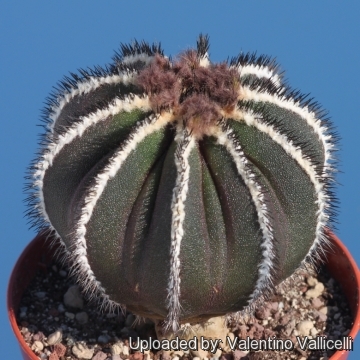 Uebelmannia pectinifera Photo by: Valentino Vallicelli
Uebelmannia pectinifera Photo by: Valentino Vallicelli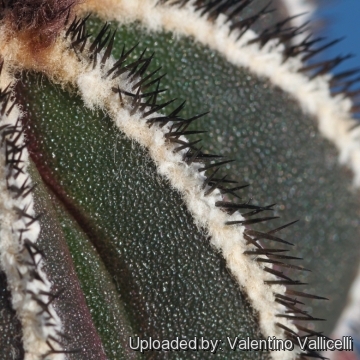 Uebelmannia pectinifera Photo by: Valentino Vallicelli
Uebelmannia pectinifera Photo by: Valentino Vallicelli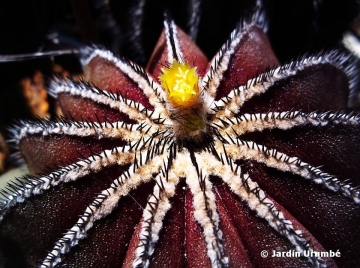 Uebelmannia pectinifera. First bloom. Photo by: Alexander Arzberger
Uebelmannia pectinifera. First bloom. Photo by: Alexander ArzbergerCultivation and Propagation: This tropical cactus loves warm moist, humid conditions and mist spraying is a must in summer. Water regularly during the growing season and use a very draining mineral potting substrate. At the onset of winter, do not water. Uebelmannias need heat all year round and extra winter heat, minimum 10C is best. Avoid any frost. Keep cool in summer. This plant prove to be root prone if kept too cold in winter. To help stop this, a good deep collar of pumice or lava grit is an excellent idea. It prefers a position in full sun, and possibly afternoon shade in summer. If you can place it so that this occurs, the plant will be much happier.
Propagation: Seeds, but plants are often grafted, making them easier to grow, particularly through the winter. If possible using a rootstock that is more hardy than the Uebelmannia is ideal.
Your Photos

by Cactus Art
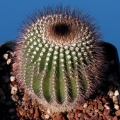
by Valentino Vallicelli
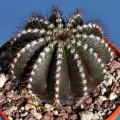
by Valentino Vallicelli

by Valentino Vallicelli

by Valentino Vallicelli























